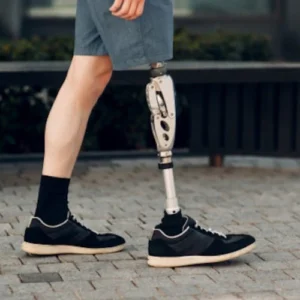
Slowly but surely, the pipeline of data about osseointegration (OI) is starting to flow. The most recent example appeared in February’s edition of the journal Gait & Posture, which presents a rigorous clinical study about one of OI’s presumed benefits: improved balance and gait stability.
Conducted by an interdisciplinary team of researchers from the University of Colorado’s pioneering OI center, the study measured the gait characteristics of ten above-knee amputees pre- and post-osseointegration. The key finding: Participants became steadier both biomechanically and psychologically after OI, exhibiting a more consistent stride while reporting greater confidence in their walking.
“To our knowledge, these are the first results to demonstrate the positive effect that osseointegrated prostheses have on static and dynamic balance measures,” the authors wrote. “These results indicate that this novel prosthesis may [reduce] fall risk, which is significant considering the heightened fall risk of patients with amputation who regularly use a socket prosthesis.”
All the study subjects opted for OI after many years of using conventional socket-based prostheses. They averaged 20 years since their amputations and ranged from 38 to 55 years old, with an average age of 46. The majority lost limbs due to cancer or trauma; only one had a vascular cause.
The researchers outfitted each participant with more than 30 sensors to measure walking speed, stride length, center of gravity, ground force, postural sway, and other components of ambulation. Surprisingly, the subjects walked more slowly after OI. Decreased pace typically correlates with pain, laborious gait, and/or fear of falling, but the authors suggest that in this instance, it indicates increased comfort and confidence.
In support of their hypothesis, the researchers cited the longer stance phase on the amputated limb during each gait cycle, “which indicates greater confidence and ability to spend a longer amount of time on the amputated limb with an osseointegrated prosthesis as compared to a socket prosthesis.” They added, “Many patients within our cohort qualitatively reported that when using their osseointegrated prosthesis, they did not feel the same urgency to complete the walking trials due to discomfort experienced within their socket prosthesis.”
Two other important biomechanical markers, step width and length, both became more stable after OI. Participants also exhibited greater balance while standing, which the authors hypothesize is the result of improved proprioception and osseoperception, defined as the ability to sense force, pressure, gravity, and other mechanical stimuli.
Finally, and perhaps most meaningful, the participants were significantly more confident on their feet after OI. This value was measured via the Activities-Specific Balance Confidence (ABC) scale, which captures individuals’ subjective, self-reported sense of balance. Before OI, the study participants averaged ABC scores of about 70 (on a 0 to 100 scale), which is typical for socket-wearing unilateral amputees. After OI, the ABC average shot up to the high 80s.
“We hypothesize that this population is more confident in their ability to maintain balance as they are more comfortable, have greater prosthesis satisfaction, and increased levels of osseoperception compared to a socket prosthesis,” the authors noted, adding that greater confidence supports increased levels of physical activity and social interaction.
“This investigation was the first to demonstrate the effect of osseointegrated prostheses on static and dynamic balance,” the authors concluded. “While this is an important first step in establishing the influence of prosthesis osseointegration on balance, our future work will continue to evaluate balance mechanisms following prosthesis osseointegration to determine if this novel prosthesis lowers fall risk.”













